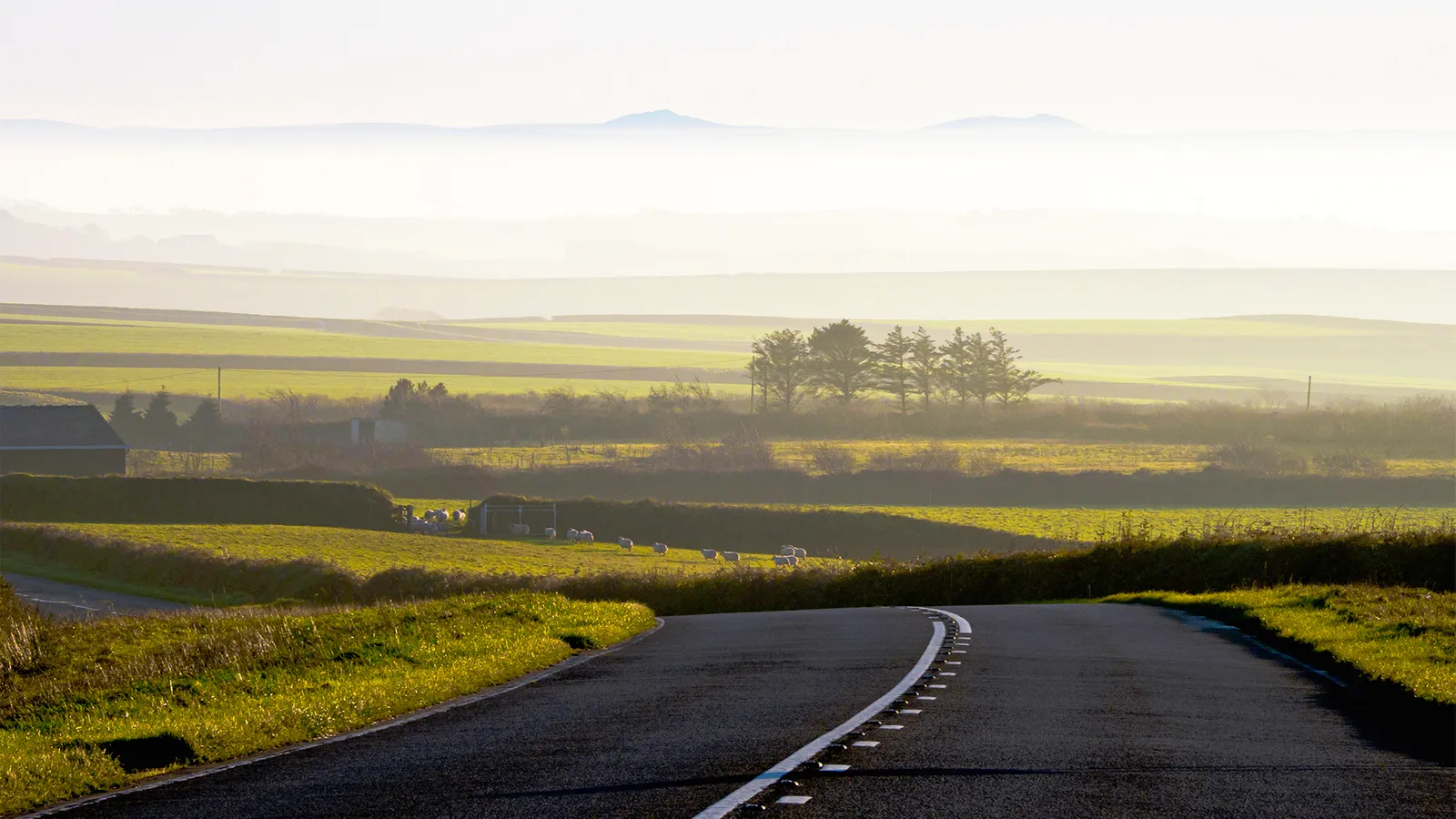A39: England's remote Atlantic Highway
A 70-mile strip of the A39 is more than just another thoroughfare. It's where generations of Cornish ingenuity blend with an influx of newcomers seeking a more rural life.

Locals wouldn't say there's much romantic about the A39, a national highway that crosses south-west England. To most, it is a convenience at best, a site of accidents at worst – so many accidents, in fact, that it has the unfortunate reputation as Cornwall's deadliest road, the likely result of everything from its often-narrow, winding nature to some tricky junctions.
But the A39 – particularly the section dubbed the "Atlantic Highway", a 70-mile strip that runs from Barnstaple, Devon, to Newquay, Cornwall – is more than just another thoroughfare. It is one of the only arteries connecting an especially disconnected part of what is already a remote region.
That remoteness means two things. For one, it helps keep the area relatively wild. To be clear, north Cornwall is not a secret. The summer tide of tourists is felt everywhere, the area's carparks, beaches and pubs frothing over with visitors. But it's almost always possible to find a quiet cove or a cafe filled with locals. In the off-season, even the most popular spots can be empty. And aside from Tintagel Castle of King Arthur fame, none of Cornwall's top 10 most-popular attractions sit here.
The remoteness, especially given the area's lack of train stations, also means that there are few good ways to explore the area.
I lived in this area with my family for two years. In that time, I fell in love with north Cornwall's ocean views, rolling farmland and dramatic cliffs, but with its lesser-known attractions, too. Despite its remote and rural nature, north Cornwall is dotted with farm-(and sea)-to-table favourites, art galleries and unique museums devoted to everything from witchcraft to military history – the result of generations of Cornish ingenuity and artisanal heritage blended with an influx of newcomers seeking a more rural life, many of them even before Covid.
And so, when my family, lured by a job opportunity, chose to move out of England, I knew I had to explore this special region one last time. And that meant one thing: taking to the road, specifically the A39. This entailed navigating twists, turns and, more annoyingly, the odd overzealous car that rode my bumper if I dropped a mile or two below the speed limit. But it still made for an easier drive than many of the smaller, single-track roads that link up to the A39. Then there were the benefits of using the main highway: its convenience but also – surprisingly – its moments of beauty.
Despite its name, the Atlantic Highway runs mostly through patchworked fields, bucolic villages and emerald-green woodland, with occasional slices of sea seen from a distance. Technically, it starts seven miles inland of Newquay, home to Cornwall's only public airport.
This first section skirts some of the heart of Poldark country and the locations where some of the television series' lushest landscapes were filmed, including Park Head and Porthcothan. I headed here first. This is the Cornish landscape at its most dramatic and striking, the wildflower-covered cliffs plunging down to sandy coves, lapped by blue-green water. After a hike along the South West Coast Path, I quickly worked up an appetite.
Luckily, one of England's prime "food capitals", Padstow, is just eight miles north off the A39. Once a pretty fishing village, today Padstow is better known for its restaurants. Rick Stein launched his culinary empire here, while Tripadvisor travellers recently rated Padstow as being the best place for Michelin-quality meals in the world.So, it was only fair that I tried out the Michelin-starred Paul Ainsworth at No. 6, a restaurant known for its inventive plays on Cornish fare. While No. 6 pays homage to the area's fishing heritage, it doesn't overlook Cornwall's more land-locked offerings. Sometimes in one dish – like my first course, a warmed, raw scallop in an acorn ham broth with kohlrabi tartare.
"It's a prerequisite that we have got incredible fish and shellfish," said chef Chris McClurg, the restaurant's chef de cuisine. "But what often goes overlooked is the quality and standard of the husbandry and farming in Cornwall."
One of their most beloved dishes, for example, is a main course called "all the pigeon" – that uses every part of the bird in ingenious ways. A roast leg is wrapped in kataifi pastry (made of fine strands of shredded phyllo dough) and fried; the livers whipped into a parfait; the offal, mixed with dark chocolate, turned into a "pain au chocolat" and dipped into a "ketchup" made from Japanese sour plums. I'd never known a pigeon to be turned into such a balanced mix of sweet and savoury, crunch and tenderness.
But one of my favourite dishes was the simplest: a buttered scone. The scone itself was one thing. Then the server brought a glimmering yellow log. He hovered a knife through a candle flame, then glided it through the log with a motion that felt almost visceral. The butter tasted as good as it looked, creamy and lush, heightened with just the right amount of Cornish sea salt.
Despite its reputation, Padstow is far from the only place nearby to find good food. Back on the A39, I drove the 10 miles north to St Kew. I was still full from my Michelin-starred experience – which is available as a set tasting menu only. But if I hadn't been, right off the highway is one of the area's finest farm shops, St Kew Farm Shop & Cafe, serving up a short menu of changing specials (think buttermilk-fried chicken with local slaw and jalapeno cornbread) and top-notch coffee, as well as one of my favourite grilled cheese sandwiches in the area, made with local sourdough and cheddar from Davidstow creamery just down the road. Or there's local favourite Aunt Avice's Pasty Shop, whose hot, fresh-baked Cornish pasties often sell out early in the day.
Turning through the quaint village of St Kew, I headed along one of the smaller B-roads to the coast. Before long, the single-track road, high hedges on either side, opened up to the blue of the sea. Compared to its neighbours, Port Quin is a hidden gem. The only people here were a small group of kayakers bobbing out on the water. After popping coins in the car park's honesty box, I headed up the coastal path to walk off some of my lunch, ducking through thickets of blueberries beaded with rain.
Another couple of miles up the coastal road (or 3.5 miles up the path) is Port Isaac. Made especially famous by the long-running series Doc Martin, airing its final series this year, it is the quintessential Cornish coastal town: whitewashed cottages, small harbour, narrow lanes, and on either side, cow-dotted hills with steep cliffs and views of the blue ocean. Like its neighbour Tintagel, it is one of north Cornwall's better-known destinations.
For something lesser-known, though, I prefer St Nectan's Glen, where a short hike takes you through an ancient woodland to a towering waterfall. Over time, visitors have strung the surrounding trees with prayer flags and ribbons, a practise often seen at sacred sites in Cornwall, and have built "faerie stacks" of stones. At the top of the glen perches an old hermitage, said to have been the residence of the 6th-Century saint Nectan himself. It's a spot that feels as mystical as any King Arthur castle.
-bbc







